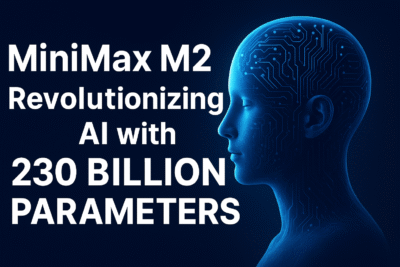Introduction to MiniMax M2
MiniMax M2 is a large language model (LLM) with an astonishing 230 billion total parameters, optimized specifically for AI agent workflows and coding tasks. Launched on October 27, 2025, it signifies a new era in Chinese AI development, competing head-to-head with frontier models from Western companies like OpenAI and Anthropic. Unlike traditional general-purpose models, MiniMax M2 was built from the ground up with an agent-first philosophy, enabling it to perform complex multi-step workflows involving tool invocation, reasoning, and code generation.
The model’s core purpose is to bridge the gap between high performance and accessibility, democratizing advanced AI capabilities. Its design ensures that it is not merely a theoretical or research-oriented model but a practical tool suitable for enterprise deployment, individual developers, and AI researchers. Its open-source nature is pivotal, providing free access to weights, fine-tuning capabilities, and a platform for customization and safety evaluation.
The Architecture of MiniMax M2
At the heart of MiniMax M2 lies an innovative mixture-of-experts (MoE) architecture. This design allows the model to activate only a small subset of its total parameters during each inference, significantly increasing efficiency without sacrificing performance. Specifically, out of 230 billion total parameters, only 10 billion are active during inference.
This sparse activation delivers several critical benefits:
- Speed: M2 can process approximately 100 tokens per second, roughly twice as fast as the Claude Sonnet 4.5 model from Anthropic.
- Cost Efficiency: Because fewer parameters are active at one time, the computational requirements are greatly reduced, enabling deployment on consumer-grade hardware.
- Flexibility: The large parameter pool enables the model to develop specialized expertise across diverse tasks, ensuring high-quality performance across coding, reasoning, and agent workflows.
Such an architecture makes M2 suitable for deployment on less powerful hardware, like consumer GPUs, which is rare for models of this size, normally requiring extensive resources.
Industry-Leading Performance and Benchmarks
MiniMax M2 performance on several benchmark tests has set new standards for open-source models. It achieved a top-five ranking on Artificial Analysis’s overall intelligence index, surpassing models like Google DeepMind’s Gemini 2.5 Pro. Its score of 61 points places it just behind GPT-5, Grok 4, and Claude Sonnet 4.5—benchmarking the model’s competitive edge.
Notably, M2 excels in reasoning tasks, agentic workflows, and code generation. It scored:
- 69.4 on SWE-bench Verified, showcasing its prowess in real-world coding tasks.
- 77.2 on τ²-Bench, highlighting its tool use and multi-step reasoning capabilities.
- 44.0 on web research benchmarks, denoting strong browsing and research functions.
Its ability to handle multi-step workflows makes it particularly suitable for complex automation, programming assistance, and agent orchestration.
Agent-Centric Design & Multimodal Capabilities
Unlike many other large models, MiniMax M2 embraces an agent-first design philosophy. This focus means the model is natively optimized for stable long-chain tool calling, enabling it to execute complex workflows seamlessly. The model supports:
- Shell commands for scripting
- Browser automation for web research
- Python code execution in isolated environments
- Integration with external tools like GitHub, Slack, and Figma via MCP (Model Context Protocol)
Skyler Miao, head of engineering at MiniMax, emphasizes that MiniMax M2 is designed for “thinking” — enabling it to carry reasoning across multiple steps, making it suitable for agent automation tasks that require multi-tool invocation.
Moreover, the model supports multimodal inputs, including text, images, and potentially audio, further expanding its versatility in practical applications like content creation, research, and automation.
Open-Source Commitment and Developer-Friendly Features
A major differentiator for MiniMax M2 is its open-source status. The company immediately released the model weights on Hugging Face, allowing developers to:
- Download and fine-tune the weights for specific use cases
- Deploy on private infrastructure without relying on proprietary APIs
- Audit the safety, bias, and ethical characteristics of the model
- Build customized derivatives without licensing restrictions
This transparency adheres to the core tenets of open-source development and aligns with the broader AI community’s push for transparency and safety.
Cost and Accessibility
One of the most striking aspects of MiniMax M2 is its cost-effectiveness. The model is offered at approximately 8% of the cost of Claude Sonnet 4.5, with a charge of around $0.3 per million input tokens and $1.2 per million output tokens. This pricing structure makes advanced AI accessible to small and mid-sized organizations, startups, and individual developers, who traditionally could not afford the compute costs associated with large models.
Furthermore, the company is currently offering free API access for a limited time, encouraging rapid adoption and community engagement.
Deployment and Future Outlook
MiniMax M2’s deployment support includes popular platforms like vLLM and SGLang, facilitating quick and efficient integration into existing workflows. The open-source approach ensures that organizations can deploy the model in their on-premise data centers, maintaining data privacy and security.
The ongoing development of M2 includes plans for enhanced multimodal processing, improved safety mechanisms, and broader language support. Its success signals a significant shift in the global AI landscape: Chinese developers are increasingly competing with and, in some areas, surpassing Western models in performance, efficiency, and transparency.
Broader Implications
MiniMax M2’s emergence as a top-tier open-source AI model has several implications:
- Democratization of AI: With powerful features available for free or at low cost, more organizations and researchers can innovate without prohibitive expenses.
- Accelerating AI Research: Open weights and transparent safety audits foster collaborative improvement and safer deployment.
- Competitive Dynamics: As Chinese AI firms like MiniMax deliver frontier models, the global AI race intensifies, pushing innovation across borders.
- Open-Source Leadership: MiniMax’s decision to release the model openly sets a precedent for the industry, emphasizing transparency and collaboration.
Conclusion
MiniMax M2 exemplifies how cutting-edge AI technology can be made accessible without compromising performance. Its innovative mixture-of-experts architecture, agent-centric capabilities, and open-source model weights position it as a formidable player in the AI ecosystem of 2025. As it continues to evolve, M2 is likely to influence AI development strategies worldwide, promoting democratization, transparency, and innovation. For developers, research labs, and organizations seeking an efficient, scalable, and cost-effective AI solution, MiniMax M2 offers a compelling option—one that is shaping the future of open-source AI.
For more such updates and latest news on cars and bikes stay connected to times.motormitra.in
Thank you ..




